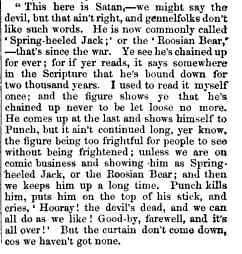"...Spring-heeled Jack became one of the most popular characters of the
period. His alleged exploits were reported in the newspapers and became
the subject of several Penny Dreadfuls and plays performed in the cheap theatres that abounded at the time. The devil was even renamed "Spring-heeled Jack" in some Punch and Judy shows..."
"There is no one definitive "story" of Punch and Judy. As expressed by Peter Fraser in Punch & Judy
(1970), "the drama developed as a succession of incidents which the
audience could join or leave at any time, and much of the show was
impromptu." This was elaborated by George Speaight in his Punch & Judy: A History
(1970), who explained that the plotline "is like a story compiled in a parlour game of Consequences ... the show should, indeed, not be
regarded as a story at all but a succession of encounters." The most
recent academic work, Punch & Judy: History, Tradition and Meaning
by Robert Leach (1985), makes it clear that "the story is a conceptual
entity, not a set text: the means of telling it, therefore, are always
variable." The story was intentionally episodic so that passers by on
the street could easily join the audience during a performance (Crone
1058)."




No comments:
Post a Comment